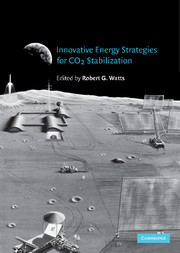Book contents
- Frontmatter
- Contents
- List of contributors
- 1 Concerns about Climate Change and Global Warming
- 2 Posing the Problem
- 3 Adaptive Strategies for Climate Change
- 4 Energy Efficiency: a Little Goes a Long Way
- 5 The Potential of Renewable Energy to Reduce Carbon Emissions
- 6 Carbonless Transportation and Energy Storage in Future Energy Systems
- 7 What Can Nuclear Power Accomplish to Reduce CO2 Emissions
- 8 Nuclear Fusion Energy
- 9 Energy Prosperity Within the Twenty-first Century and Beyond: Options and the Unique Roles of the Sun and the Moon
- 10 Geoengineering the Climate: History and Prospect
- Index
6 - Carbonless Transportation and Energy Storage in Future Energy Systems
Published online by Cambridge University Press: 22 October 2009
- Frontmatter
- Contents
- List of contributors
- 1 Concerns about Climate Change and Global Warming
- 2 Posing the Problem
- 3 Adaptive Strategies for Climate Change
- 4 Energy Efficiency: a Little Goes a Long Way
- 5 The Potential of Renewable Energy to Reduce Carbon Emissions
- 6 Carbonless Transportation and Energy Storage in Future Energy Systems
- 7 What Can Nuclear Power Accomplish to Reduce CO2 Emissions
- 8 Nuclear Fusion Energy
- 9 Energy Prosperity Within the Twenty-first Century and Beyond: Options and the Unique Roles of the Sun and the Moon
- 10 Geoengineering the Climate: History and Prospect
- Index
Summary
By 2050 world population is projected to stabilize near ten billion. Global economic development will outpace this growth, achieving present European per capita living standards by quintupling the size of the global economy – and increasing energy use, especially electricity, substantially. Even with aggressive efficiency improvements, global electricity use will at least triple to 30 trillion kWh/yr in 2050. Direct use of fuels, with greater potential for efficiency improvement, may be held to 80 trillion kWh (289 EJ) annually, 50% above present levels (IPCC, 1996). Sustaining energy use at these or higher rates, while simultaneously stabilizing atmospheric greenhouse gas levels, will require massive deployment of carbon-conscious energy systems for electricity generation and transportation by the mid 21st century. These systems will either involve a shift to non-fossil primary energy sources (such as solar, wind, biomass, nuclear, and hydroelectric) or continue to rely on fossil primary energy sources and sequester carbon emissions (Halmann and Steinberg, 1999). Both approaches share the need to convert, transmit, store and deliver energy to end-users through carbonless energy carriers.
Carbonless Energy Carriers
Electricity is the highest quality energy carrier, increasingly dominant throughout the world's energy infrastructure. Ultimately electricity use can expand to efficiently meet virtually all stationary energy applications, eliminating stationary end-use carbon emissions. This approach is unlikely to work in transportation, however, due to the high cost and low energy density of electricity storage.
- Type
- Chapter
- Information
- Innovative Energy Strategies for CO2 Stabilization , pp. 181 - 210Publisher: Cambridge University PressPrint publication year: 2002
- 1
- Cited by



